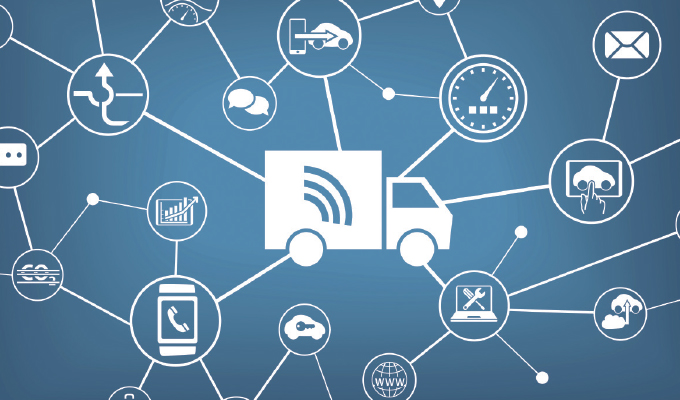In the fast-evolving world of trucking, telematics can offer impressive benefits. However, choosing whether they are a good fit for your organization can be complicated. Telematics integrates telecommunications and informatics to provide real-time data insights that can help optimize operations, enhance safety, and refine risk management strategies. We contacted two industry specialists, Cliff Johnson, and A.J. Gajdosik, to learn more.
They will explore the benefits and drawbacks of telematics for trucking operations. They detail implementation challenges and strategic considerations for harnessing the full potential of telematics.
MWS: WHAT ARE THE BENEFITS OF TELEMATICS FOR MY TRUCKING BUSINESS?
Cliff JOHNSON: Telematics can offer advantages to trucking operations by providing actionable data. Take this example scenario to illustrate how telematics can benefit your business.
Without telematics — A customer calls requesting an estimated time of arrival. Dispatch calls the driver, who checks the GPS and gives dispatch an estimate for arrival. Dispatch calls the customer back to relay the information.
With telematics — A customer calls requesting an estimated time of arrival. Dispatch checks the location of the truck in the telematics platform. Based on its location, moving speed, and destination, the program provides an ETA that dispatch provides to the customer.
In this example, telematics helps reduce driver distraction, shortens the customer response time, prevents estimating errors, and cuts out at least one phone call for your dispatch team. It illustrates the general format for telematics use: the product delivers information you use to make informed decisions that benefit your business.
Instead of manually collecting data on your operational needs, telematics systems collect the information. Telematics can provide data on many critical areas, including fuel consumption, vehicle speed, driver behavior, engine diagnostics, and vehicle location, so the advantages span many trucking applications.
MWS: WHAT CHALLENGES COULD BE FACED WHEN IMPLEMENTING TELEMATICS IN MY TRUCKING BUSINESS?
JOHNSON: Cost is always a factor. Trucking margins are thin, and the investment into telematics can be significant. Beyond the initial hardware, ongoing costs like data subscriptions and maintenance can add up and should factor into the financial evaluation. Each fleet must do its due diligence to determine if the cost savings in human resources, increased efficiencies, and safety justify the costs.
Introducing the technology to your employees can be a challenge. While detailed information can help you manage your business, it may feel invasive to some employees. Communication can help in this regard. Setting clear expectations for your employees about how you will be using the technology, how it may benefit them and what you will be doing with the information can reduce some of the fear of telematics in your fleet. Many drivers understand the benefits of telematics and may be able to help explain the pros and cons to their coworkers.
Telematics is a tool, not a solution. It provides information, but the information you receive needs to be acted upon to yield benefits. In the beginning, the amount of information you receive may be overwhelming. Over time, you will learn what data is available and how to channel it into results.
MWS: IS MY TRUCKING COMPANY READY TO COMMIT TO TELEMATICS?
JOHNSON: I recommend asking yourself the following questions to gauge readiness to commit to a telematics product.
Do you have resources available to interpret the data and monitor the systems?
Having the necessary infrastructure and personnel to manage and interpret telematics data is imperative. Do you have staff available to respond to alerts? Are you prepared to train your employees and troubleshoot issues that arise? I have spoken with trucking managers who purchased a telematics tool and turned off the notifications because they were triggered too often, rendering them useless. I have also talked with owners who have invested in dash cameras and disabled them because of driver backlash. For telematics to provide value, you must invest time, money, and attention.
Are you prepared to act on the information you receive?
If your system tells you a driver is regularly speeding, are you prepared to follow up with corrective action? If your system alerts about an engine issue, are you prepared to take that truck out of service for preventive maintenance? Telematics may uncover uncomfortable truths about your employees and system. If you are collecting data without using insights to make decisions, you may, at best, not be making the most of your investment and, at worst, be creating a paper trail that leaves you vulnerable to increased liability.
MWS: HOW TO USE TELEMATICS DATA FOR PREDICTIVE MAINTENANCE AND ASSET MANAGEMENT IN A TRUCKING FLEET?
AJ GAJDOSIK: Telematics can use sensors to monitor the baseline performance of a part and alert you to deviations from the norm before the issue escalates. By continuously monitoring vehicle diagnostics and performance metrics, telematics can alert you to potential issues before they escalate. Telematics can help you plan scheduled downtime and facilitate predictive maintenance.
You may use the data to improve maintenance and roadside inspections. For instance, brakes, lights, and tires are the most common roadside hazards found during a DOT inspection. Telematics can help you determine if a unit is idling excessively, leading to increased maintenance costs. If brakes and tires wear faster on one unit than others, the driver may be speeding and braking excessively. Some telematics systems integrate with driver electronic logging devices, allowing for the recording of pre-trip and post-trip inspections, which should notice broken or burnt-out lighting.
MWS: HOW CAN I BEST INTEGRATE TELEMATICS WITH EXISTING SYSTEMS AND PROCESSES TO IMPROVE SAFETY?
GAJDOSIK: Make sure your foundation is solid before you try to add additional complexity. Adding telematics cannot replace building a safety culture, but it can enhance systems you have in place.
Gamification can be a powerful driver of behavior, and telematics can provide insights to take things like driver scorecards to the next level. Telematics can show drivers how they perform in areas like sharp cornering, idling, speeding, and hard braking compared to their peers. A driver scorecard can encourage drivers to hold themselves and others accountable. People are often competitive, so creating a ranking system based on behavior can encourage drivers to make better decisions. You can create competition and camaraderie through team incentives if everyone reaches a certain level and individual rewards for hitting goals.
Another way to integrate telematics into existing systems is through formal metrics-based programs. Having a progressive discipline program before implementing telematics can establish driver expectations for what will happen if data shows unsafe behavior. Telematics can provide records to back up your policies and aid in performance evaluations.
MWS: HOW COULD TELEMATICS IMPACT A TRUCKING COMPANY’S INSURANCE PREMIUMS AND RISK MANAGEMENT PROCESSES?
GAJDOSIK: Telematics can be a double-edged sword. It creates a paper trail, which can reflect positively or negatively on the state of your organization. If used effectively, telematics can support proactive risk management practices by identifying potential safety issues or compliance gaps before they result in incidents or citations.
This proactive approach can enhance safety and strengthen overall risk management strategy, improving insurability and reducing the likelihood of costly claims. It can help you document improvements made and identify areas to work on. It also can be invaluable during claims processing and dispute resolution. Real-time data from telematics systems can provide objective evidence of events leading up to accidents. This information can help your insurance company defend your livelihood in a claim.
Telematics can also work against you. If you are collecting data that shows unsafe driver behavior and do not act, you may create a paper trail that shows you are not taking safety seriously. Implementing telematics before you are prepared to use the information you receive may leave you vulnerable to increased liability.
Telematics can be a powerful tool to support your organization’s efforts. It can improve efficiency, customer service, and security and take safety and risk management to the next level. It is not a one-size-fits-all solution. The needs of a dump truck differ from those of a sanitation truck or a long-haul trucking fleet. There are many aspects of telematics and fleets are encouraged to consider how their program may be structured to benefit their operation.
Fortunately, fleets do not have to learn this alone. Ask similar fleet operations what they have and if there are any pros or cons. Many vendors allow for testing of their equipment in a few trucks to help determine what is needed, what works, and what their customer service is like before you sign on the dotted line.
About the Authors

Cliff Johnson is the trucking segment business consultant at Acuity Insurance. Cliff began his trucking career by operating intrastate before expanding his operations into 48 states and Canada. He now uses his trucking experience to enhance the partnership between truckers and their insurance partners.

A.J. Gajdosik is a senior loss control representative at Acuity Insurance. He is a Certified Safety Professional and earned the Associate in Risk Management and Associate in Risk Management for Public Entities designations from the Insurance Institute of America.




